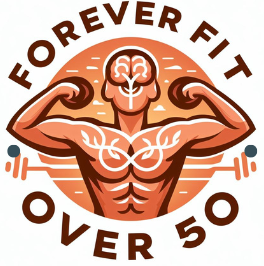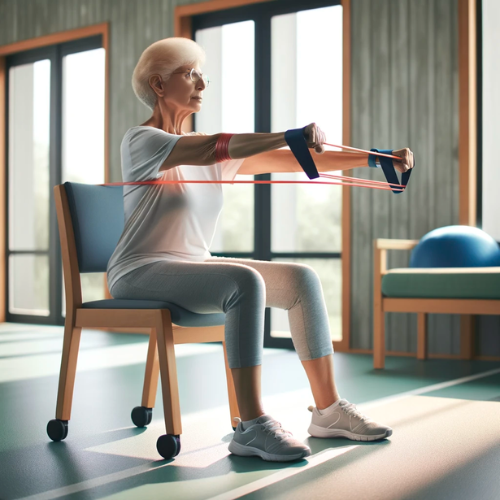Embracing Fitness at 50: The Benefits of Resistance Band Training

The golden years post-50 do not signify a slowdown in life but rather an opportunity to embrace fitness with vigor and vitality. For those navigating the nuances of working out in later life, resistance band training emerges as a remarkably adaptable and effective regimen. This lightweight and versatile tool is perfectly suited to meet the unique physical needs and considerations of the older demographic.
Resistance bands, elastic bands used for strength training, offer a gentle yet effective means of enhancing muscular strength, balance, and flexibility. They allow for a broad range of motion and can be adjusted to cater to various fitness levels, making them ideal for older adults. Studies and experts in the field of geriatric fitness underscore the significance of resistance training in promoting healthy aging, advocating for its integration into regular fitness routines to combat age-related decline in muscle mass and function.
Starting Safely: Pre-Workout Considerations for Seniors

Before embarking on a new exercise journey with resistance bands, it’s imperative for seniors to consult with a healthcare provider. This precautionary step ensures that the chosen exercises align with individual health conditions and fitness levels. Understanding one’s current physical state and setting achievable goals are crucial in creating a sustainable and beneficial workout plan.
Selecting the appropriate resistance band is another key consideration. Bands come in various levels of tension, from light to heavy, and the right choice depends on one’s initial strength and the specific exercise being performed. Additionally, ensuring a safe workout environment—free from trip hazards and with ample space—is essential to prevent injuries.
Remember to Always consult your doctor prior to engaging in any fitness programs.
Developing a Balanced Resistance Band Routine

Creating a balanced resistance band routine is fundamental for individuals over 50, ensuring that every major muscle group is engaged to promote overall strength, flexibility, and balance. This comprehensive approach not only aids in developing muscular harmony but also plays a critical role in preventing overuse injuries. Including flexibility exercises is paramount to enhance the joint range of motion, which is especially crucial as flexibility tends to decrease with age.
To start, focus on incorporating exercises that target both the upper and lower body, ensuring a well-rounded routine. Below is an example of a beginner-friendly resistance band workout plan that can be performed 2-3 times per week, allowing for adequate rest between sessions:
- Warm-Up (5-10 minutes): Start with gentle dynamic stretches and light cardio movements like marching in place to prepare your body for exercise.
- Upper Body Exercises:
-
- Band Pull-Aparts: Targets the rear deltoids and upper back. Hold the band with both hands in front of you and pull it apart, keeping your arms straight.
- Bicep Curls: Stand on the band and hold the ends with both hands. Curl your hands up toward your shoulders, keeping your elbows close to your body.
- Tricep Extensions: Hold the band overhead with both hands, then stretch it by extending your forearms. Keep your elbows close to your head.
- Lower Body Exercises:
-
- Squats: Stand on the band with feet shoulder-width apart and hold the ends with your hands at shoulder level. Squat down as if sitting back into a chair, then stand back up.
- Leg Presses: Lie on your back with the band wrapped around your feet. Push against the band as if pressing something with your feet.
- Glute Bridges: Lie on your back, band wrapped around your thighs just above the knees. Lift your hips towards the ceiling, squeezing your glutes at the top.
- Core and Flexibility:
-
- Plank: Focus on core stability. Hold the plank position, resting either on your forearms or hands, keeping a straight line from head to heels.
- Seated Band Rows: Sit with legs extended, wrap the band around your feet, and row the band towards your waist, focusing on squeezing your shoulder blades together.
- Cool Down (5-10 minutes): Finish with static stretches focusing on all major muscle groups worked during the session. Include stretches for the shoulders, chest, back, legs, and hips to enhance flexibility and aid recovery.
Incorporating Flexibility: Enhancing joint range of motion is a crucial aspect of a balanced routine. Include stretches using the resistance band to improve flexibility in muscles that have been worked. Stretching should be gentle, holding each stretch for 15-30 seconds without bouncing, to safely increase flexibility over time.
Frequency and Recovery: For beginners, especially those over 50, starting with two sessions per week is advisable, gradually increasing to three as fitness improves. Rest and recovery are as important as the workout itself. Ensure you incorporate rest days into your schedule to allow muscles to recover and prevent injury.
Variety in Exercises: To maintain balance and avoid overuse injuries, rotate through different exercises targeting the same muscle groups across workouts. This variety not only prevents boredom but also ensures comprehensive muscle engagement for optimal strength and flexibility development.
By adhering to these key principles and incorporating the example routine, individuals over 50 can build a strong foundation in resistance band training, paving the way for improved physical health and well-being.
Progressing Your Practice: Increasing Intensity Safely Over Time

Monitoring progress is key in any fitness regimen. For resistance band workouts, progress can be gauged by the ease with which exercises are completed and the ability to perform more repetitions over time. To continue reaping the benefits of resistance training, individuals should gradually increase the resistance level of the bands or incorporate more challenging exercises into their routine.
Seeking professional guidance from a fitness trainer experienced in working with older adults can provide personalized advice on advancing one’s workout regimen. Furthermore, maintaining motivation is crucial for long-term success, and celebrating every achievement, no matter how small, can boost morale and encourage persistence.
Supporting Your Resistance Band Workouts: Nutrition and Lifestyle Tips

Nutrition plays a pivotal role in supporting resistance band workouts. A balanced diet rich in protein, healthy fats, and carbohydrates fuels muscle recovery and growth, while staying hydrated optimizes exercise performance and overall health. Incorporating rest days and active recovery activities, such as walking or yoga, is essential for allowing muscles to heal and preventing burnout.
Lastly, joining a community, whether online or in-person, that shares a commitment to fitness can offer invaluable support and accountability. Engaging with peers on a similar journey fosters a sense of camaraderie and motivation, making the fitness journey not only more enjoyable but also more sustainable.
In conclusion, resistance band training offers a flexible, effective, and safe approach to fitness for individuals over 50. By starting cautiously, developing a balanced routine, progressively challenging oneself, and supporting workouts with proper nutrition and a supportive community, older adults can enjoy the myriad benefits of resistance training, enhancing their quality of life and embracing a healthier, more active lifestyle.
Here’s a little transparency: Our website contains affiliate links. This means if you click and make a purchase, we may receive a small commission. Don’t worry, there’s no extra cost to you. It’s a simple way you can support our mission to bring you quality content.


Hey a great post you have here!
It was not only interesting to read but certainly helpful and inspiring too. Once you get older, some people start to decrease workouts and other sorts of exercise, believing it is no longer required or beneficial however this is false. In fact you should try to incorporate various exercise forms to enable strong bones and help the body and muscles.
This post certainly should be shared since it also contains important precautions such as the significance of warms ups.
Thanks again and have a great day!
Hello Sariya,
Thank you so much for your wonderful comment! I’m truly delighted to hear that you found the post on Resistance Band Workouts for Over 50s not only interesting but also helpful and inspiring. You’re absolutely right about the misconception some have regarding exercise as we age. It’s so important to continue incorporating varied forms of exercise into our routines to maintain strong bones, muscles, and overall health.
I’m glad you highlighted the importance of warm-ups and precautions, as safety and wellbeing are paramount in any fitness journey, especially as we get older. Your encouragement to share the post means a lot, and I hope it reaches many more who will find it beneficial.
Thank you again for your kind words and support. Wishing you a fantastic day filled with positivity and wellness!
Warm regards,
Gary
I’ve been incorporating resistance bands into my routine after noticing my workouts were becoming monotonous. This article offered fresh perspectives and exercises that I hadn’t considered before. The detailed breakdown of each movement has been incredibly helpful, especially in ensuring I maintain proper form. I appreciate the focus on safety and adaptability for those of us over 50. Can’t wait to add these into my weekly schedule!
Hi Corey,
I’m thrilled to hear that the article on resistance band workouts has injected some new energy into your fitness routine! Your enthusiasm for embracing new exercises and prioritizing form is key with most exercises and motivation. You have touched on the core values we hold dear, especially the commitment to safety and adaptability for individuals over 50.
The versatility and effectiveness of resistance bands make them an excellent choice for keeping workouts engaging and beneficial, ensuring that you can continue to challenge yourself while respecting your body’s needs. It sounds like you’re on a fantastic path, and incorporating these exercises into your weekly schedule is sure to bring even more positive changes to your fitness journey.
Remember, the journey to maintaining and enhancing our fitness as we age is ongoing, and it’s the small, consistent steps that lead to lasting results. I can’t wait to hear about your progress and how these exercises are working out for you. Keep embracing the journey with curiosity and enthusiasm, and always feel free to reach out with your experiences or if you’re seeking further advice.
Warmest regards,
Gary
Hello Gary,
I find this article insightful and well-structured. The emphasis on safety and the importance of consulting with a healthcare provider before starting any exercise routine is crucial, especially for individuals over 50. The inclusion of a beginner-friendly resistance band workout plan is helpful, providing a clear and diverse set of exercises for both the upper and lower body.
The connection between nutrition, hydration, and a balanced lifestyle with resistance band training is a great addition, emphasising the holistic approach to overall well-being. The encouragement to join a fitness community for support and motivation is a positive and practical suggestion.
Thank you for sharing your thoughts!
Hi Starlight
Thank you deeply for your kind words and for taking the time to share your thoughts on the “Resistance Band Workouts for over 50” article. I’m grateful to hear you found the article insightful and appreciated the emphasis on safety and the importance of consulting with a healthcare provider. It’s crucial to approach fitness with care, especially as we age, and I’m glad that message struck a chord with you.
I’m also delighted you found the beginner-friendly resistance band workout plan to be clear and useful. My goal is to provide accessible exercises that cater to both the upper and lower body, ensuring a comprehensive approach to fitness that can be embarked upon with confidence and ease.
Your acknowledgment of the holistic approach to well-being, linking nutrition, hydration, and a balanced lifestyle with resistance band training, means a lot. It’s a testament to the interconnected nature of health, and I’m pleased it another struck a chord with you. Additionally, the suggestion to join a fitness community is close to my heart, as I believe in the power of support and motivation in achieving our health goals.
Thank you once again for your encouraging feedback. It’s comments like yours that inspire me to continue creating content that supports and educates. Here’s to a journey of health, strength, and community!
Warmest regards,
Gary